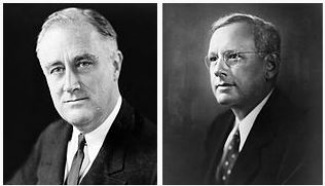 A sampling error led to an embarrasing and wrong prediction. A sampling error led to an embarrasing and wrong prediction. Tags: methodology/statistics, politics/election/voting, quantitative methodology, sampling bias, sampling frame, straw poll, survey research, 00 to 05 mins Year: 1989 Length: 1:03 Access: YouTube Summary: A fundamental part of survey research is collecting a representative sample. This video illustrates the importance of this by showing how a biased sampling procedure led to a huge prediction error in the 1936 presidential election between Franklin D. Roosevelt and Alf Landon. Even though one sample size was enormous (more than 2.3 million respondents), it could not fix a fundamentally flawed sampling procedure, and incorrectly predicted that Landon would win the election. The sampling frame (the list of people from whom the sample was chosen) was built from lists of automobile and telephone numbers, which many low and middle income voters could not afford in the 1930's. Therefore, its sample reflected people with higher class backgrounds and "missed the larger pro-Roosevelt sentiment among low-income voters." In short, it did not reflect the population, leading to a very embarrassing and fatal error for the polling company (especially since Roosevelt won with 62% of the vote). This is also known as a straw poll, or a poll used to gauge political opinions that is conducted poorly or without utilizing proper sampling methods. At the same time, Gallup conducted a poll and correctly predicted the winner, based on a fraction of the sample size (50,000 respondents). Note this clip is from Program 14 of the Against All Odds series, and even more can be found here under the tab "Select a Video Unit." Submitted By: Bhoomi K. Thakore
3 Comments
Great article, Bhoomi K. Thakore! Thank you for highlighting the crucial importance of representative sampling in predicting elections. It's remarkable how a flawed sampling procedure can lead to such a significant prediction error. Your article serves as a powerful reminder that accurate data collection is paramount in understanding public sentiment.
Reply
Manuel Franco
7/29/2023 02:11:05 am
I just want to say Thank You to everyone who supported me through the years. My name is Manuel Franco, New Berlin, Wisconsin. My story of how I won the Powerball lottery of $768.4M is a bit of a tale. I have been playing Powerball tickets for 6 years now since I turned 18. I bought my first ticket on my 18 birthday. I was feeling very lucky that day because I had contacted Dr. Odunga Michael to help me with the winning Powerball numbers. I really had that great great feeling that I looked at the camera wanting to wink at it. I only did a tiny part of it and trusted him. He gave me the numbers after I played a couple other tickets along with it for $10. I checked my ticket after the winnings came online and saw the numbers were correct including the Power play. I screamed for about 10 minutes because it felt like a dream. I had won $768.4M. You can check my winning testimony with the lottery officials just with my name search. Thank you Dr Odunga. Well, his email is [email protected] and you can also call or Whats-app him at +2348167159012 so you guys can contact him
Reply
mark hold
7/7/2024 03:37:52 pm
Herbal Penis Enlargement product is 100% guaranteed to Enlarge and get a better ERECTION, the reason why most people are finding it difficult to enlarge Penis is that they believe in medical reports, drugs and medical treatment which is not helpful for Penis Enlargement. Natural roots/herbs are the best remedies which can easily Enlarge your Penis permanently Contact Dr MOSES BUBA via Email: [email protected] or via WhatsApp: +2349060529305. for Natural root and herbal remedies put together to help Enlarge manhood and Erect healthily. I also learn that Dr MOSES BUBA also can cure other types of diseases, HEPATITIS B,DIABETICS,CANCER,HPV,LOW SPERM CAM, HIV/STDS, FIBROSIS LOST OF WEIGHT, BREAST ENLARGEMENT, HIPS and BUMS ENLARGEMENT etc .
Reply
Leave a Reply. |
Tags
All
.
Got any videos?
Are you finding useful videos for your classes? Do you have good videos you use in your own classes? Please consider submitting your videos here and helping us build our database!
|
 RSS Feed
RSS Feed
